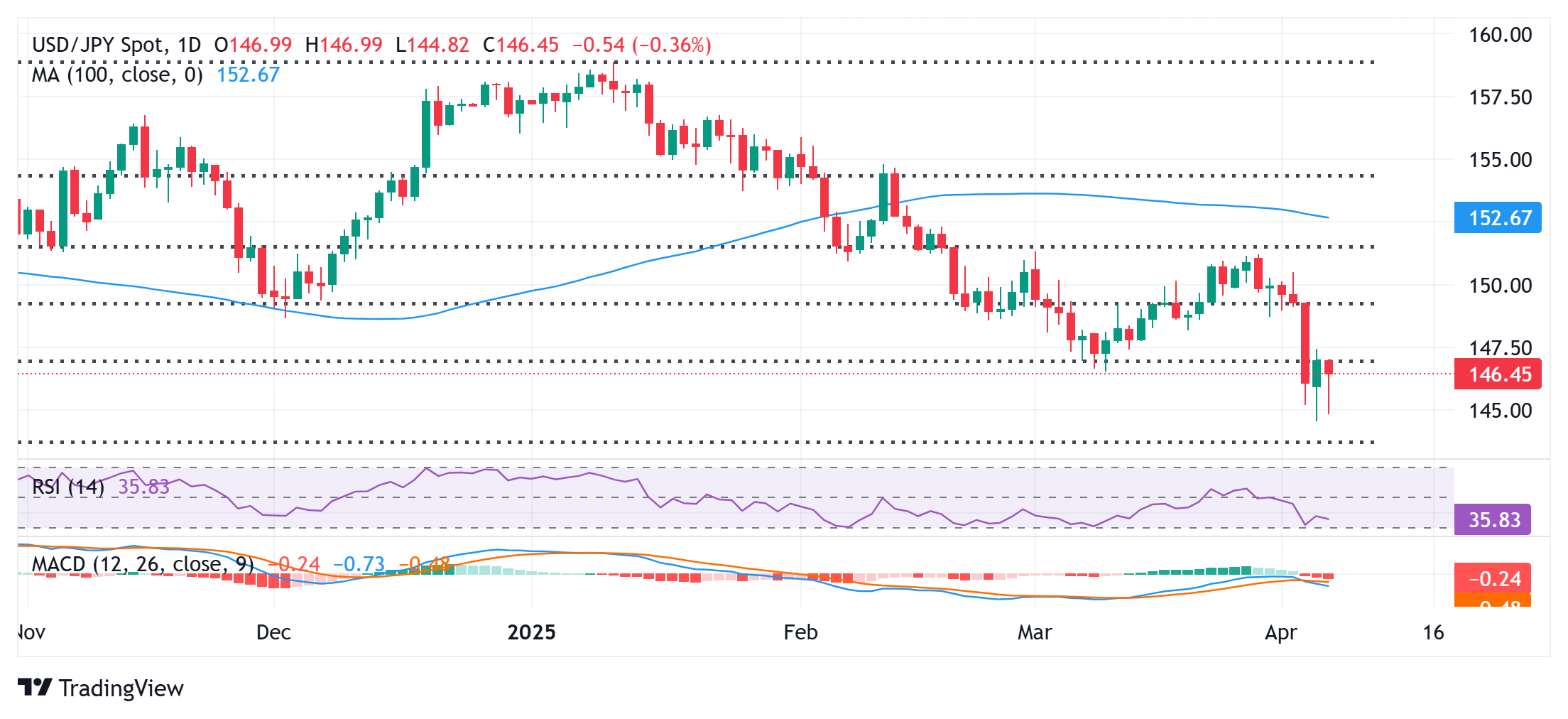Created
: 2025.04.07














![]() 2025.04.07 12:22
2025.04.07 12:22
The Japanese Yen (JPY) kicks off the new week on a positive note as US President Donald Trump's sweeping reciprocal tariffs raise the risk of a global economic slowdown and continue to underpin traditional safe-haven assets. Meanwhile, concerns that harsher US reciprocal tariffs could negatively impact Japan's economy forced investors to scale back their bets that the Bank of Japan (BoJ) would raise the policy rate at a faster pace. This, in turn, acts as a headwind for the JPY and assists the USD/JPY pair to reverse an Asian session dip back closer to a six-month low - levels below the 145.00 psychological mark - touched on Friday.
However, signs of broadening inflation in Japan keep the door open for further BoJ interest rate hikes in 2025. Apart from this, persistent geopolitical tensions should limit any meaningful depreciating move for the JPY. The US Dollar (USD), on the other hand, struggles to capitalize on Friday's positive move amid bets for more aggressive policy easing by the Federal Reserve (Fed), fueled by concerns about a tariffs-driven US economic slowdown. This, along with a further steep decline in the US Treasury bond yields, should act as a tailwind for the lower-yielding JPY and cap any meaningful recovery move for the USD/JPY pair.

From a technical perspective, last week's breakdown and acceptance below the 61.8% Fibonacci retracement level of the September-March positive move was seen as a fresh trigger for the USD/JPY bears. Moreover, oscillators on the daily chart are holding deep in negative territory and are still away from being in the oversold zone. This, in turn, suggests that the path of least resistance for spot prices remains to the downside. Hence, any subsequent recovery beyond the 147.00 mark (61.8% Fibo. level) might be seen as a selling opportunity and remain capped near the 147.70 region. This is followed by the 148.00 round figure, which if cleared decisively might trigger a near-term short-covering rally.
On the flip side, the 146.00 mark, followed by the 145.45 region, the 145.00 psychological mark Asian session low, around the 144.80 region, and a multi-month trough, around the 144.55 region touched on Friday, could act as immediate support levels. Some follow-through selling below the latter will reaffirm the negative bias and make the USD/JPY pair vulnerable to accelerate the downfall further toward the 144.00 round figure.
The Japanese Yen (JPY) is one of the world's most traded currencies. Its value is broadly determined by the performance of the Japanese economy, but more specifically by the Bank of Japan's policy, the differential between Japanese and US bond yields, or risk sentiment among traders, among other factors.
One of the Bank of Japan's mandates is currency control, so its moves are key for the Yen. The BoJ has directly intervened in currency markets sometimes, generally to lower the value of the Yen, although it refrains from doing it often due to political concerns of its main trading partners. The BoJ ultra-loose monetary policy between 2013 and 2024 caused the Yen to depreciate against its main currency peers due to an increasing policy divergence between the Bank of Japan and other main central banks. More recently, the gradually unwinding of this ultra-loose policy has given some support to the Yen.
Over the last decade, the BoJ's stance of sticking to ultra-loose monetary policy has led to a widening policy divergence with other central banks, particularly with the US Federal Reserve. This supported a widening of the differential between the 10-year US and Japanese bonds, which favored the US Dollar against the Japanese Yen. The BoJ decision in 2024 to gradually abandon the ultra-loose policy, coupled with interest-rate cuts in other major central banks, is narrowing this differential.
The Japanese Yen is often seen as a safe-haven investment. This means that in times of market stress, investors are more likely to put their money in the Japanese currency due to its supposed reliability and stability. Turbulent times are likely to strengthen the Yen's value against other currencies seen as more risky to invest in.
![]()
Created
: 2025.04.07
![]()
Last updated
: 2025.04.07

FXStreet is a forex information website, delivering market analysis and news articles 24/7.
It features a number of articles contributed by well-known analysts, in addition to the ones by its editorial team.
Founded in 2000 by Francesc Riverola, a Spanish economist, it has grown to become a world-renowned information website.
We hope you find this article useful. Any comments or suggestions will be greatly appreciated.
We are also looking for writers with extensive experience in forex and crypto to join us.
please contact us at [email protected].
Disclaimer:
All information and content provided on this website is provided for informational purposes only and is not intended to solicit any investment. Although all efforts are made in order to ensure that the information is correct, no guarantee is provided for the accuracy of any content on this website. Any decision made shall be the responsibility of the investor and Myforex does not take any responsibility whatsoever regarding the use of any information provided herein.
The content provided on this website belongs to Myforex and, where stated, the relevant licensors. All rights are reserved by Myforex and the relevant licensors, and no content of this website, whether in full or in part, shall be copied or displayed elsewhere without the explicit written permission of the relevant copyright holder. If you wish to use any part of the content provided on this website, please ensure that you contact Myforex.
Myforex uses cookies to improve the convenience and functionality of this website. This website may include cookies not only by us but also by third parties (advertisers, log analysts, etc.) for the purpose of tracking the activities of users. Cookie policy